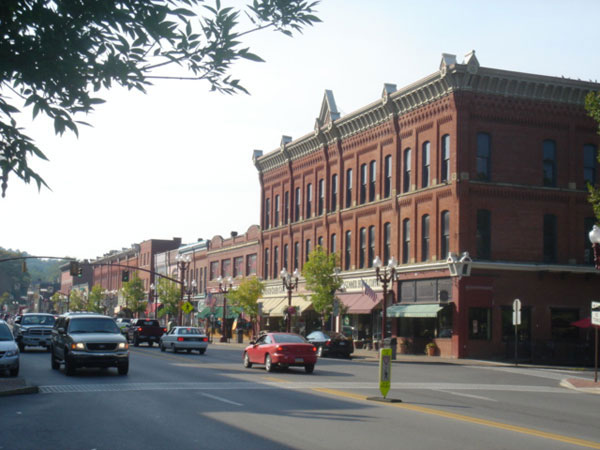Liberty Street: Franklin, Pennsylvania

Summary
The sense of pride and ownership community leaders and residents have for Liberty Street can be traced back to 1852 when a group of volunteer citizens collected and planted oak, maple, and chestnut trees in Fountain Park, one of two downtown parks on the street.
Designated Area
Four blocks between 14th Street to the west and South Park Street to the east.

Liberty Street functions as a pedestrian corridor while also accommodating traffic from three highways. Traffic-calming measures and pedestrian-only alleys make the street accessible and easily navigable to those traveling by foot. Photo courtesy of the City of Franklin.
Planning Excellence
More recently, that community spirit has led residents to join together to buy old store buildings for renovation into theaters and museums. In 1980, the city established the Facade Improvement Grant Program that helped restore more than 60 building fronts along the street to help businesses remain attractive and competitive with stores at a shopping mall located nearby.
These efforts resulted in handsomely restored historic buildings that reflect seven different architectural styles and form a perfect backdrop for the street's everyday activity.
It was the region's mid-19th century oil boom that brought prosperous times to the area and led to the demise of the street's original wooden structures, which were torn down and replaced with impressive brick buildings, including the county's crown jewel — the commanding, twin-spired Italianate Venango County Courthouse.
Although Liberty Street handles through traffic from three major highways — U.S. Routes 8, 62, and 322 — it also accommodates non-motorized use. Pedestrian-only alleys decorated with hand-painted murals are located mid-block on both sides of Liberty between 13th Street and West Park Street. The walkways enable residents and visitors to easily access Liberty and off-street parking lots while avoiding busy intersections.

Restored building facades and 19th century-style lampposts add to Liberty Street's pedestrian experience and historic character. Photo courtesy of the City of Franklin.
Defining Characteristics, Features
Historic Architecture
- Town surveyed in 1795 by Andrew Ellicott, who did final survey for Washington, D.C.; original plan identifies Liberty Street as main thoroughfare and two downtown public spaces — Bandstand and Fountain parks
- Main artery for Franklin Historic District (added to National Register 1984)
- Italianate, Second Renaissance Revival, Beaux Arts, Neo-Colonial, Moderne, Classical Revival and Victorian style architecture found on street
- The brick Venango County Courthouse (1867), 1168 Liberty St., designed by Sloan & Hutton of Philadelphia; downtown centerpiece
- Historic District Code (1979) requires Historic and Architectural Review Board, city council approval for facade changes along street visible by pedestrians
- United States Hotel (1806), 1213-1221 Liberty St., frequented by John Wilkes Booth; today used for office space and restaurant
- Four Pennsylvania Historical Museum Commission markers highlight important buildings, places and events regarding the 19th century oil boom; most notable is Dodd-Osmer Building, 1249 Liberty St., home to law office of Samuel C.T. Dodd, a Franklin native and author of Standard Oil Trust
Community Engagement
- Barrow-Civic Theatre, 1223 Liberty St.; previously an out-of-business retail sports outlet, bought by Franklin Civic Operetta, a local musical theater company, in 1989; hundreds of volunteers helped revamp the building into a 500-seat theater; a former drugstore next door was converted into a children's theater in 2004
- DeBence Antique Music World, 1261 Liberty St.; museum opened in 1994 after a volunteer committee was able to preserve the DeBence family collection of antique mechanical music instruments and raise $1.2 million to secure the current downtown site of the museum
- The Commons at Franklin, 1340 Liberty St.; originally a private club dating back to the late 1800s, was purchased in 2005 by individuals and renovated to include a pub and a dining area that accommodates large receptions, community gatherings
Vibrant Downtown
- Annual three-day Applefest held the first weekend of October; attracts more than 100,000 visitors to Liberty Street and its parks; established by Franklin Area Chamber of Commerce (1983); one of seven major yearly events on street
- Liberty Galleria, 1255 Liberty St., established in cooperation with Franklin Area Chamber of Commerce in 2009, provides retail space for start-up businesses
- No vacant lots along designated blocks of Liberty Street
- Twice-weekly Farmer's Market next to courthouse
- Downtown Building Fund (2004) helps finance projects creating upper-level housing units in buildings along the street; $10,000 per unit matching grants
- Five municipal parking lots located no more than one block off of Liberty Street between 14th Street and 12th Street — two to the north and three to the south; no parking lots or structures border or are visible from Liberty Street
- Survey of Venango County residents (2004) shows 59 percent visit Liberty Street and downtown Franklin at least once a week

With no empty lots, Liberty Street features unbroken rows of historic buildings forming the backbone of Franklin's commercial district. Residents have played a major role in the preservation of Liberty Street's historic storefronts. Photo courtesy of the City of Franklin.
Pedestrian Friendly
- Engine Brake Ordinance prohibits compression braking along Liberty to reduce the loud exhaust noise made by trucks and create a more peaceful downtown
- $1.2 million streetscape improvement project began in 1980s; followed by revitalization efforts in 1999 including rehabilitation of sidewalks, traffic calming
- Six alleys along Liberty made into pedestrian-only corridors, four decorated with murals; two on north side connect to Elk Street; three on south side connect to Buffalo Street
- Overhead wiring in front of courthouse eliminated to improve streetscape, views
- Inlaid thermoplastic reflective overlay in crosswalks and fluorescent warning signs alert drivers to pedestrians
- Mid-block traffic light, crosswalk between 13th and West Park streets
- Period lamp posts with hanging flower baskets, street clock from early 1900s, and 19 benches add to pedestrian experience; bike lanes planned for street


